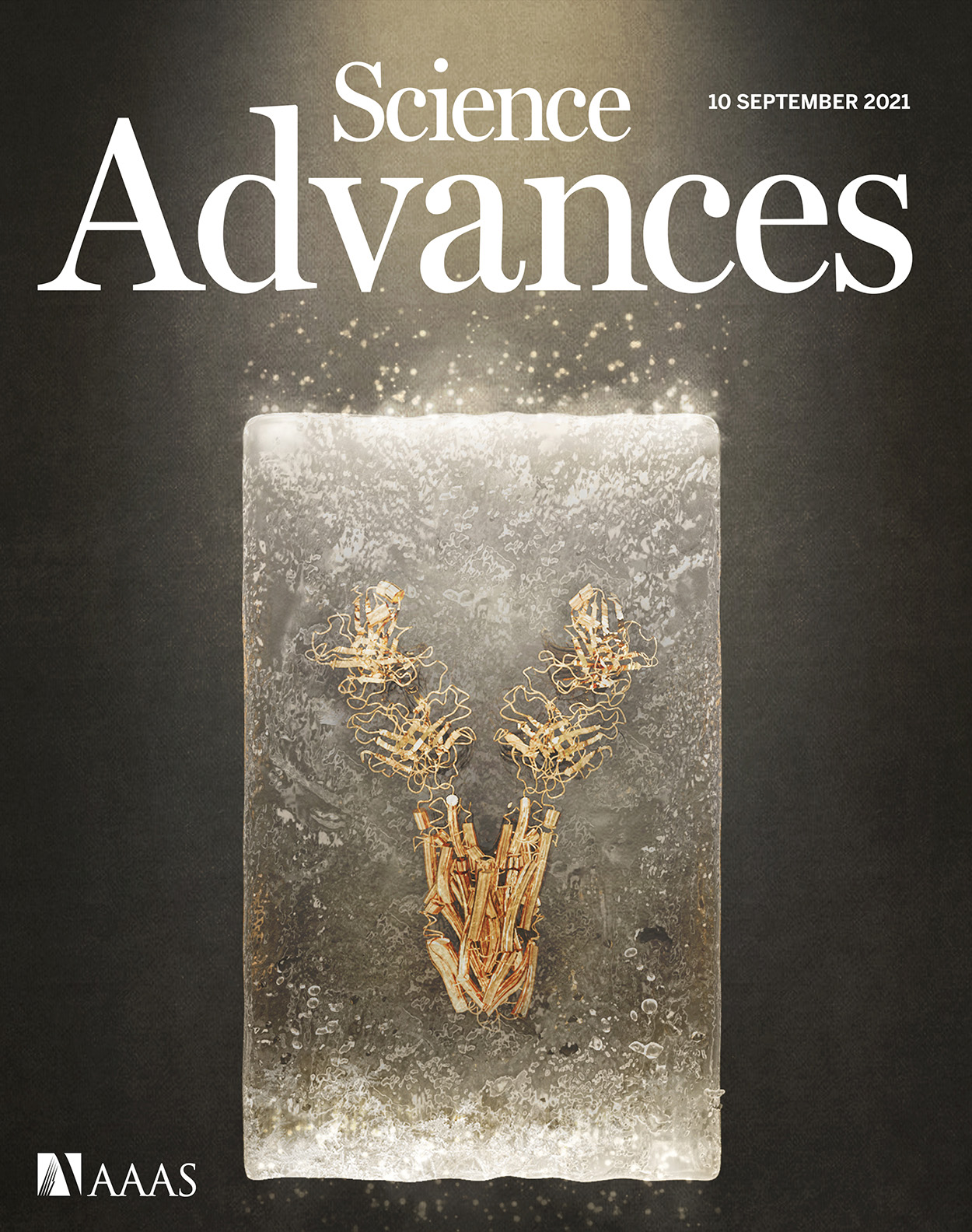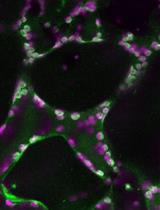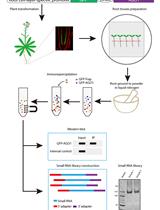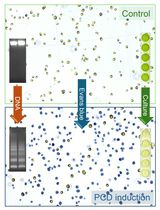- EN - English
- CN - 中文
A Detailed Guide to Recording and Analyzing Arabidopsis thaliana Leaf Surface Potential Dynamics Elicited by Mechanical Wounding
拟南芥机械损伤引发的叶片表面电位动态记录与分析详解指南
发布: 2025年04月05日第15卷第7期 DOI: 10.21769/BioProtoc.5252 浏览次数: 1124
评审: Raju MondalAnonymous reviewer(s)
Abstract
Recordings of electric potential changes on plant surfaces have been utilized to identify the components and mechanisms involved in the formation and transmission of systemic signals elicited by stimuli such as herbivory, wounding, or burning. The recorded responses, commonly referred to as slow wave or variation potentials, exhibit striking variability in their waveform. The extent to which this variability is due to differences in experimental procedures or plant biological variability remains unclear. Here, we provide a detailed and robust protocol refined from years of experience in conducting leaf surface potential recordings of Arabidopsis thaliana in response to mechanical wounding. This protocol serves as a comprehensive tutorial covering plant growth, procedures for reproducible mechanical wounding, critical aspects of electrophysiological recordings, and statistical analysis of surface potential recordings. It particularly emphasizes the construction and maintenance of electrodes, placement of the reference or ground electrode, mechanisms for wounding, and data analysis. This protocol aims to promote and facilitate the adoption, standardization, and interoperability of plant surface potential recordings among research groups, thereby increasing the reproducibility and comparability of data within the field.
Key features
• Recording electric potential changes on the petiole of 5-week-old Arabidopsis plants using noninvasive surface electrodes, improving the wounding procedure, reproducibility, and data processing from [1].
• Genotype-independent method for phenotyping, including parallel recordings from multiple plants.
• Guidelines for plant growth conditions, unambiguous leaf assignment by order of emergence, and detailed instructions for electrode fabrication and maintenance.
• Instructions for constructing devices for standardized, reproducible mechanical wounding along with a custom script for unbiased and semi-automated data analysis.
Background
The first known recorded electrical impulses in plants date back to the 19th century from a modified leaf surface of a Venus flytrap (Dionaea muscipula) [2]. Later studies investigated surface potential dynamics in other thigmonastic organs in plants such as Mimosa pudica. Inserted electrode measurements in plants were first performed in the 20th century [3] and, decades later, led to the identification of ion channels as the basis of electrical signals in plants [4]. Modern studies have shown that various environmental stimuli such as light, heat, cold, and wounding trigger electrical signals [5]. Plants can utilize these signals to share information over long distances between organs and to regulate physiological functions [6].
In order to measure electric potential changes in plants, two methods are commonly used: extracellular and intracellular recordings. Although intracellular recordings offer higher precision and cellular resolution, they are typically only effective for short durations due to factors such as cell damage from electrode insertion. Extracellular recordings on the surface of plants are noninvasive, allowing long-term monitoring, but they do not provide information about the electric potential changes of individual cells or specific tissues. Both intracellular and extracellular recordings help identify and monitor diverse electric potential changes, such as action potentials (APs) and slow wave potentials (SWPs). APs are short-lasting, self-propagating electrical signals with a fixed amplitude that can be elicited by stimuli such as cold shock. SWPs are long-lasting electrical signals with variable amplitudes and waveforms that are caused by severe local damage. Unlike APs, SWPs do not self-propagate and require chemical and mechanical signals for generation [7]. The method described here provides detailed instructions for reliably detecting these highly variable changes in plant surface potential.
Materials and reagents
Biological materials
1. Arabidopsis thaliana (L.) Heynh. (Col-0), available from the European Arabidopsis Stock Centre (NASC), the Arabidopsis Biological Resource Center (ABRC), or similar germline resources
Reagents
1. Murashige & Skoog (MS) basal salt mixture, including MES buffer (Duchefa, catalog number: M0254.0050)
2. Low electroendosmosis (LE) agarose (Biozym, catalog number: 840000)
3. Potassium chloride (KCl) (VWR, catalog number: 26764.3)
4. Silver chloride (AgCl) (Sigma-Aldrich, catalog number: 204382-5G)
5. Ethanol (C2H5OH) (Supelco/Merck, catalog number: 1070172511)
6. Sodium hypochlorite (NaOCl) 13% (Fisher Scientific, catalog number: 10691164)
7. Ammonium hydroxide (NH4OH) 25% (Sigma-Aldrich, catalog number: 1336-21-6)
8. DanKlorix® original (2.8 g per 100 mL of sodium hypochlorite) (Office discount, catalog number: 327692)
Solutions
1. 50 mM electrode solution (see Recipes)
2. 5% NaOCl (see Recipes)
3. 70% ethanol (see Recipes)
4. 1/2 MS medium (see Recipes)
Recipes
1. 50 mM electrode solution
Note: To prepare the electrode solution, slowly add AgCl to the dissolved KCl, stirring until undissolved AgCl remains, indicating saturation. Depending on whether you prepare the solution for connecting the electrode to the leaf or for the bath electrode, you need to use 0.8% or 3% LE agarose, respectively.
| Reagent | Final concentration | Quantity or Volume |
|---|---|---|
| KCl | 50 mM | 0.37 g |
| AgCl | n/a | Until saturation is reached |
| MilliQ H2O | n/a | 100 mL |
| Total | n/a | 100 mL |
| LE agarose | 0.8 or 3% (w/v) | 0.8 g or 3 g |
2. 5% NaOCl
Note: This solution has to be prepared freshly before every usage.
| Reagent | Final concentration | Quantity or Volume |
|---|---|---|
| 13% NaOCl | 5% | 3.84 mL |
| MilliQ H2O | n/a | 6.16 mL |
| Total | n/a | 10 mL |
3. 70% ethanol
| Reagent | Final concentration | Quantity or Volume |
|---|---|---|
| Ethanol (absolute) | 70% | 700 mL |
| MilliQ H2O | n/a | 300 mL |
| Total | n/a | 1,000 mL |
4. 1/2 MS medium
Note: To prevent contamination and extend shelf life, autoclave or filter-sterilize the solution. Store at room temperature (RT) if sterile; otherwise, keep at 4 °C and acclimate to RT before use.
| Reagent | Final concentration | Quantity or Volume |
|---|---|---|
| MS including MES buffer | 1/2 strength | 2.6 g |
| MilliQ H2O | n/a | 1,000 mL |
| Total | n/a | 1,000 mL |
Laboratory supplies
1. Pipette tips, 200 μL (Starlab, catalog number: S1113-1206-C)
2. PCR tubes (Sarstedt, catalog number: 72.985.002)
3. Parafilm (Carl Roth, catalog number: H666.1)
4. Forceps (Sigma-Aldrich, catalog number: F4517)
5. Trays (Meyer, catalog number: 749112/74 91 12)
6. Lids (Meyer, catalog number: 749150/74 91 50)
7. Pots 4.5 × 4.5 × 7 cm (Meyer, Göttinger, catalog number: 722001/72 20 01)
8. BP substrate (Baywa, Klasmann-Deilmann, catalog number: 1073986)
9. Vermiculite (Duengerexperte, catalog number: p89)
10. Sand (Lehmann Baustoffe, type: Rheinsand, granulation ≤2 mm)
11. Container to place the pots containing 1/2 MS media for recordings
Equipment
1. Insulating tape (Adam Hall 580813RNB10, Conrad Electronic, catalog number: 5906194000459)
2. Solder (Stannol, model: S-Sn99,3Cu0,7)
3. Soldering iron (Basetech ZD-70D, Conrad Electronic, catalog number: 4064161149202)
4. Banana plug 2 mm (Amazon, catalog number: GST-2.0MM-SCHR)
5. Optical table with sealed holes (Thorlabs, catalog number: B75120A)
6. Silver wire, >99.99% purity, 1 mm diameter (World Precision Instruments, catalog number: AGW4010)
7. Amplifier head stages (NPI Electronic GmbH, model: EXT-02F/2 B)
8. Extracellular amplifier (NPI Electronic GmbH, model: EXT-02F)
9. Digitizer (World Precision Instruments, model: Lab-Trax-4/16, 2016 B016N)
10. Micromanipulator (MM33, 3 Axes, Märzhäuser Wetzlar)
11. Grip wrench (C.K. Tools, catalog number: 000829025)
12. Desiccator (Carl Roth, catalog number: AHL0.1)
13. Microwave
14. Hotplate stirrer (IKA® C-Mag, Sigma-Aldrich, catalog number: Z672351)
15. Emery paper (Bosch Accessories J45 grit 120, Conrad Electronic, catalog number: 3165140678421)
16. 3D-printed grids for leaf wounding (self-printed; the design can be found here)
17. Permanent marker pen (Edding, model: 751)
Software and datasets
1. LabScribe: iWorx v4.345, this license is free to use for research purposes
2. LabView NI (23.1001)
3. R Studio (2023.09.0+463 or younger)
Note: All codes have been deposited toGithub.
Procedure
文章信息
稿件历史记录
提交日期: Nov 8, 2024
接收日期: Feb 20, 2025
在线发布日期: Mar 12, 2025
出版日期: Apr 5, 2025
版权信息
© 2025 The Author(s); This is an open access article under the CC BY-NC license (https://creativecommons.org/licenses/by-nc/4.0/).
如何引用
Readers should cite both the Bio-protocol article and the original research article where this protocol was used:
- Atanjaoui, F., Kleist, T. J., Barbosa-Caro, J. C. and Wudick, M. M. (2025). A Detailed Guide to Recording and Analyzing Arabidopsis thaliana Leaf Surface Potential Dynamics Elicited by Mechanical Wounding. Bio-protocol 15(7): e5252. DOI: 10.21769/BioProtoc.5252.
- Moe-Lange, J., Gappel, N. M., Machado, M., Wudick, M. M., Sies, C. S. A., Schott-Verdugo, S. N., Bonus, M., Mishra, S., Hartwig, T., Bezrutczyk, M., et al. (2021). Interdependence of a mechanosensitive anion channel and glutamate receptors in distal wound signaling. Sci Adv. 7(37): eabg4298. https://doi.org/10.1126/sciadv.abg4298
分类
植物科学 > 植物细胞生物学 > 细胞间通讯
细胞生物学 > 细胞信号传导 > 胁迫反应
您对这篇实验方法有问题吗?
在此处发布您的问题,我们将邀请本文作者来回答。同时,我们会将您的问题发布到Bio-protocol Exchange,以便寻求社区成员的帮助。
提问指南
+ 问题描述
写下详细的问题描述,包括所有有助于他人回答您问题的信息(例如实验过程、条件和相关图像等)。
Share
Bluesky
X
Copy link












